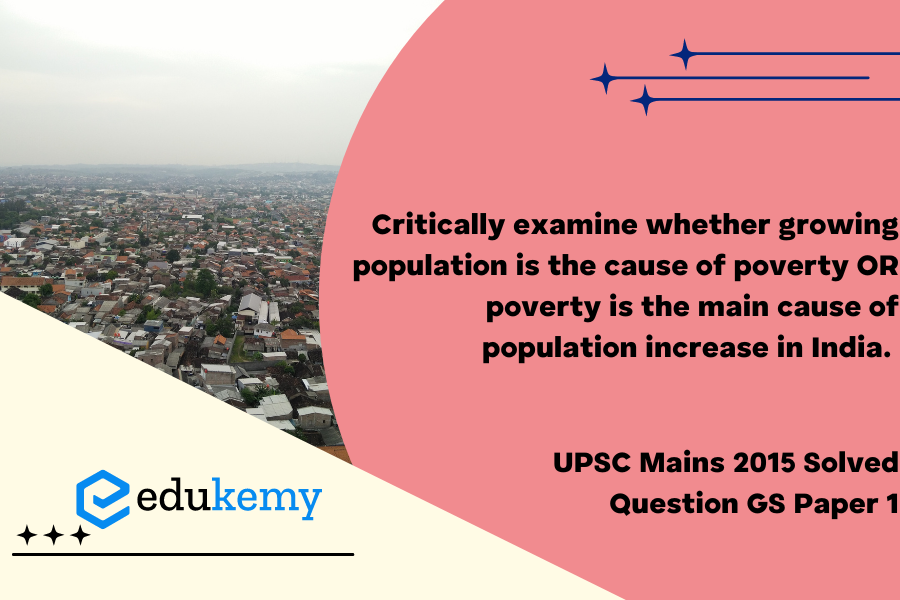
The intricate relationship between population growth and poverty in India has been a subject of extensive debate and analysis. Some argue that the burgeoning population is the root cause of poverty, contending that the pressure on resources and opportunities intensifies as more individuals compete for limited resources. This perspective emphasizes the strain on infrastructure, education, healthcare, and employment opportunities, attributing the perpetuation of poverty to the sheer size of the population. On the contrary, an opposing viewpoint posits that poverty serves as the primary driver of population increase in India. This perspective suggests that high fertility rates often prevail in economically disadvantaged communities where families may perceive more children as a form of social security or additional labor force. Poverty, thus, becomes a catalyst for larger families, perpetuating a cycle of economic hardship. Critically examining these contrasting viewpoints requires a nuanced understanding of the socio-economic dynamics in India, considering factors such as access to education, healthcare, and family planning, as well as the effectiveness of government policies aimed at addressing both population growth and poverty alleviation.
Tag: Population and associated issues.
Contents
Decoding the Question:
- In Introduction, start with defining poverty.
- In Body,
- Discuss how growing the population can be the cause of poverty.
- Discuss how poverty is the main cause of population increase.
- Conclude the answer with some recent data & initiatives.

Answer:
British economist and philosopher, TR Malthus, in his Essay the Principles of Population, 1798 says that population would grow in a geometric progression while food production would increase in arithmetic progression. Poverty is being deprived of food, medical facilities, education, jobs, shelter, power, basic amenities, etc.
- First, rapid population growth is likely to reduce per capita income growth and well-being, which tends to increase poverty.
- Second, in densely populated poor nations with pressure on land, rapid population growth increases landlessness and hence the incidence of poverty.
- Finally, the adverse effects of rapid population growth on child health, and possibly on education, will likely increase poverty in the next generation.
- Rapid population growth stretches both national and family budgets thin with the increasing numbers of children to be fed and educated and workers to be provided with jobs. Slower per capita income growth, lack of progress in reducing income inequality, and more poverty are the probable consequences.
Characteristics of poverty can cause:
- High fertility, high infant mortality, lack of education for women in particular, too little family income to invest in children, inequitable shares in national income, and the inaccessibility of family planning.
- In recent years, general agreement has emerged to the effect that improving economic conditions for individuals generally leads to lower birth rates
- Poverty and the lack of access to education lead to higher birth rates and overpopulation- according to USAID
- Population explosion has given rise to environmental pollution. There are three main reasons: First, the larger the population, the larger the demand for food and, thus, the higher the requirement for cultivable land. Second, changing lifestyles has led to evolving consumption patterns (what Mahatma Gandhi would have probably termed ‘greed’); more and bigger cars, greater number of TVs, ACs, refrigerators, mobile phones, packaged foods, furniture items, electrical gadgets of several types are being consumed widely and in greater numbers each passing day.
A country’s economic growth is often shaped by overarching demographic trends. The Millennium Development Goals (MDGs) were adopted by consensus following the United Nations (UN) Millennium Summit in 2000 where Goal 1 says -to eradicate extreme poverty and hunger. Where rapid population growth far outpaces economic development, countries will have a difficult time investing in the human capital needed to secure the well-being of its people and to stimulate further economic growth. Thus, growing population is one of the causes of poverty but poverty is the main cause of population increase in India.
In case you still have your doubts, contact us on 9811333901.
For UPSC Prelims Resources, Click here
For Daily Updates and Study Material:
Join our Telegram Channel – Edukemy for IAS
- 1. Learn through Videos – here
- 2. Be Exam Ready by Practicing Daily MCQs – here
- 3. Daily Newsletter – Get all your Current Affairs Covered – here
- 4. Mains Answer Writing Practice – here

